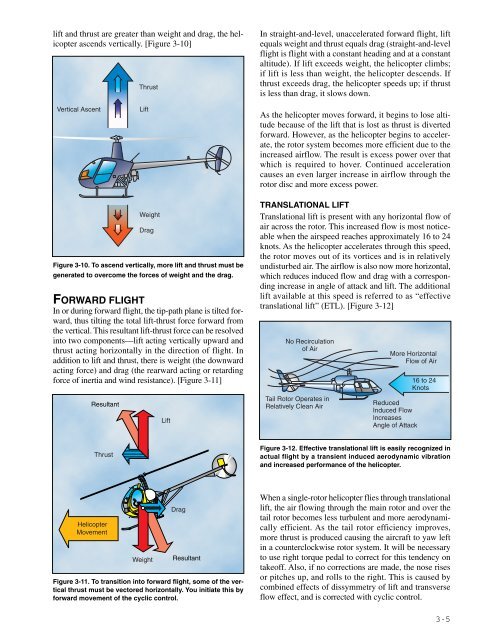Rotorcraft Flying Handbook, FAA-H-8083-21
Rotorcraft Flying Handbook, FAA-H-8083-21
Rotorcraft Flying Handbook, FAA-H-8083-21
You also want an ePaper? Increase the reach of your titles
YUMPU automatically turns print PDFs into web optimized ePapers that Google loves.
lift and thrust are greater than weight and drag, the helicopter<br />
ascends vertically. [Figure 3-10]<br />
Thrust<br />
In straight-and-level, unaccelerated forward flight, lift<br />
equals weight and thrust equals drag (straight-and-level<br />
flight is flight with a constant heading and at a constant<br />
altitude). If lift exceeds weight, the helicopter climbs;<br />
if lift is less than weight, the helicopter descends. If<br />
thrust exceeds drag, the helicopter speeds up; if thrust<br />
is less than drag, it slows down.<br />
Vertical Ascent<br />
Lift<br />
As the helicopter moves forward, it begins to lose altitude<br />
because of the lift that is lost as thrust is diverted<br />
forward. However, as the helicopter begins to accelerate,<br />
the rotor system becomes more efficient due to the<br />
increased airflow. The result is excess power over that<br />
which is required to hover. Continued acceleration<br />
causes an even larger increase in airflow through the<br />
rotor disc and more excess power.<br />
FORWARD FLIGHT<br />
In or during forward flight, the tip-path plane is tilted forward,<br />
thus tilting the total lift-thrust force forward from<br />
the vertical. This resultant lift-thrust force can be resolved<br />
into two components—lift acting vertically upward and<br />
thrust acting horizontally in the direction of flight. In<br />
addition to lift and thrust, there is weight (the downward<br />
acting force) and drag (the rearward acting or retarding<br />
force of inertia and wind resistance). [Figure 3-11]<br />
Resultant<br />
Weight<br />
Drag<br />
Figure 3-10. To ascend vertically, more lift and thrust must be<br />
generated to overcome the forces of weight and the drag.<br />
Lift<br />
TRANSLATIONAL LIFT<br />
Translational lift is present with any horizontal flow of<br />
air across the rotor. This increased flow is most noticeable<br />
when the airspeed reaches approximately 16 to 24<br />
knots. As the helicopter accelerates through this speed,<br />
the rotor moves out of its vortices and is in relatively<br />
undisturbed air. The airflow is also now more horizontal,<br />
which reduces induced flow and drag with a corresponding<br />
increase in angle of attack and lift. The additional<br />
lift available at this speed is referred to as “effective<br />
translational lift” (ETL). [Figure 3-12]<br />
No Recirculation<br />
of Air<br />
Tail Rotor Operates in<br />
Relatively Clean Air<br />
More Horizontal<br />
Flow of Air<br />
Reduced<br />
Induced Flow<br />
Increases<br />
Angle of Attack<br />
16 to 24<br />
Knots<br />
Thrust<br />
Figure 3-12. Effective translational lift is easily recognized in<br />
actual flight by a transient induced aerodynamic vibration<br />
and increased performance of the helicopter.<br />
Helicopter<br />
Movement<br />
Weight<br />
Drag<br />
Resultant<br />
Figure 3-11. To transition into forward flight, some of the vertical<br />
thrust must be vectored horizontally. You initiate this by<br />
forward movement of the cyclic control.<br />
When a single-rotor helicopter flies through translational<br />
lift, the air flowing through the main rotor and over the<br />
tail rotor becomes less turbulent and more aerodynamically<br />
efficient. As the tail rotor efficiency improves,<br />
more thrust is produced causing the aircraft to yaw left<br />
in a counterclockwise rotor system. It will be necessary<br />
to use right torque pedal to correct for this tendency on<br />
takeoff. Also, if no corrections are made, the nose rises<br />
or pitches up, and rolls to the right. This is caused by<br />
combined effects of dissymmetry of lift and transverse<br />
flow effect, and is corrected with cyclic control.<br />
3-5

















